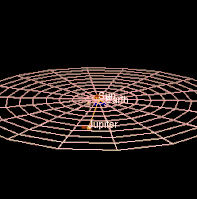Solar System showing the plane of the Earth's orbit around the Sun in 3D. Mercury, Venus, Earth, and Mars are shown in both panels; the right panel also shows Jupiter making one full revolution with Saturn and Uranus making less than one full revolution.
Our
Earth might appear as a really fantastic planet to us. But it isn't
as fantastic as we think it is. It is neither hot nor cold, neither
big nor small. But life exists only on Earth. This is the greatness
of our planet. Other planets in this solar system have their own
greatness.
Planets
can be categorised in two ways:
- Planets like Earth
- Planets like JupiterPlanets which are small and rocky like Mercury , Venus and Mars are Earth like planets.Mercury is nearer to Sun. That's why during noon the temperature will around 8000oF. But due to very thin atmosphere of M?ercury nights are very cold. Venus is similar to Earth in terms of density and area. But due to large amouts of CO2 (carbon-di-oxide) the rise in temperature is high. The surface temperature is nearly 8650oF throught the year.
In the solar system traces of water have been found only on Earth and Mars. But only Earth has large amount of water on its surface. But recent researches done by using rovers reveal that Mars had oceans just like Earth. There are still traces of frozen water on Mars. Winds blow at speeds about 70 kmph on Mars.
Saturn, Uranus and Neptune are Jupiter like planets. These planets are mainly made of gases. They contain large amounts of hydrogen and helium. These two gases are present in large amounts in the universe.
Jupiter is the largest planet. Jupiter has large amount of matter than the rest of the planets. Planets like Jupiter have rings surrounding them. But Saturn is a lot brighter than the rest.
The length of the rings surrounding Saturn is nearly 1,70,000 miles and thickness is about 100 feet. Uranus and Neptune are twin planets. The diameter, density, revolution are nearly same. Pluto has been ripped out of its status as a planet. But I fell it's worth mentioning about it. Pluto is really different from other planets. The density of Pluto is also really low. Pluto is mainly made of chunks of ice revolving around Sun.

The Sun and planets of the Solar System. Sizes are to scale. Distances not to scale.
|
|


No comments:
Post a Comment